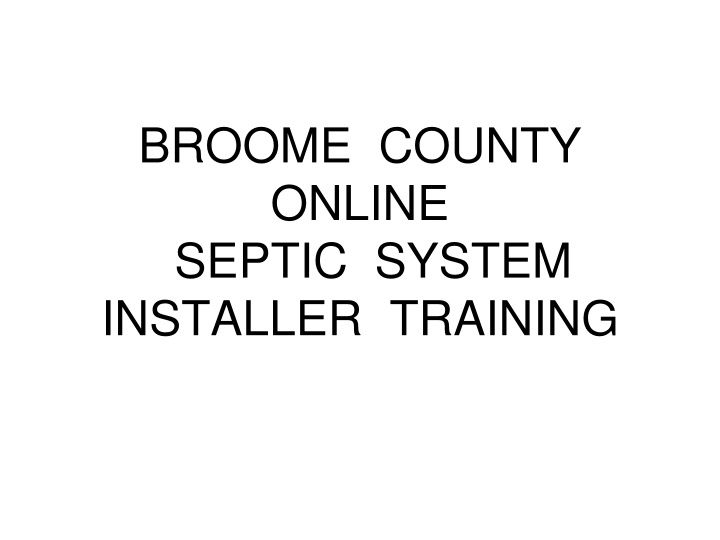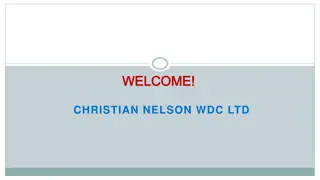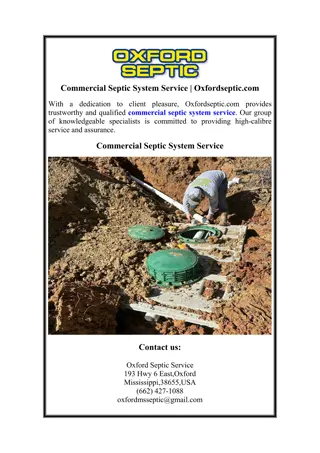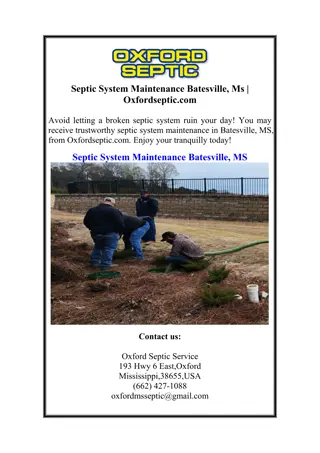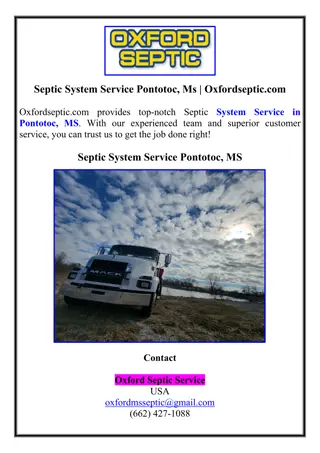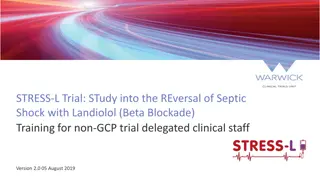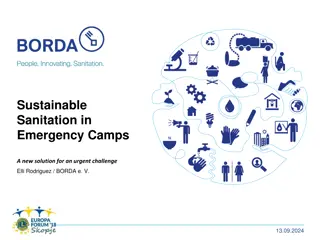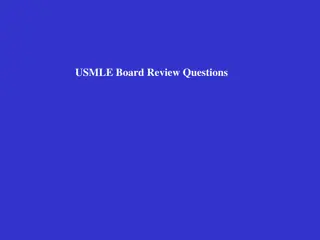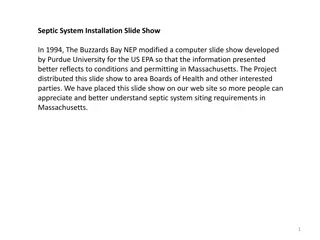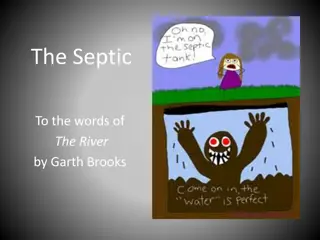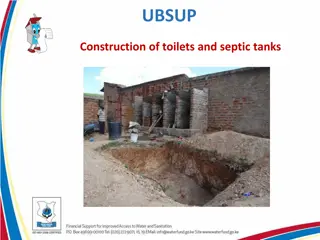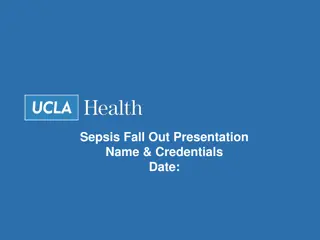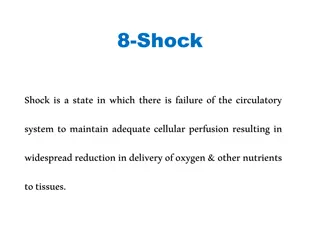Broome County Online Septic System Installer Training
This online training program focuses on developing individual residential septic systems in Broome County, aligning with engineering standards set by the New York State Department of Health. The content covers various topics such as wastewater treatment, historical notes on sanitation, and the importance of safe disposal practices to prevent diseases. Participants will learn about design standards, common problems, and inspection procedures related to septic systems.
Download Presentation

Please find below an Image/Link to download the presentation.
The content on the website is provided AS IS for your information and personal use only. It may not be sold, licensed, or shared on other websites without obtaining consent from the author.If you encounter any issues during the download, it is possible that the publisher has removed the file from their server.
You are allowed to download the files provided on this website for personal or commercial use, subject to the condition that they are used lawfully. All files are the property of their respective owners.
The content on the website is provided AS IS for your information and personal use only. It may not be sold, licensed, or shared on other websites without obtaining consent from the author.
E N D
Presentation Transcript
BROOME COUNTY ONLINE SEPTIC SYSTEM INSTALLER TRAINING
TABLE OF CONTENTS INTRODUCTION WASTEWATER & DISEASE GENERAL OVERVIEW OF SEPTIC SYSTEMS SEPARATION DISTANCES CONSTRUCTION PROCESS APPLICATION UNNECESSARY INSPECTIONS DIG SAFELY NY SITE EVALUATION (SOIL CUT) SEPTIC TANK & SYSTEM DESIGN & SIZE COMMON PROBLEMS AERATION UNITS INSPECTION FORM
INTRODUCTION PURPOSE: TO DEVELOP AN EXISTING INDIVIDUAL RESIDENTIAL SEPTIC SYSTEM THAT CORRESPONDS TO THE ENGINEERING SPECIFICATIONS AND DESIGN STANDARDS SET FORTH BY THE NEW YORK STATE DEPARTMENT OF HEALTH & BROOME COUNTY HEALTH DEPARTMENT. PURSUANT TO THE AUTHORITY OF THE COMMISSIONER OF HEALTH BY SECTION 201 (1)(l) OF THE PUBLIC HEALTH LAW, APPENDIX 75-A WASTEWATER TREATMENT STANDARDS - INDIVIDUAL HOUSEHOLD SYSTEMS, AND CHAPTER 11 OF TITLE 10 (HEALTH) OF THE OFFICIAL COMPILATION OF CODES, RULES & REGULATIONS OF THE STATE OF NEW YORK. DEPARTMENT OF HEALTH S ADMINISTRATIVE RULE S & REGULATIONS design standard (10NYCRR APPENDIX 75-A)
WASTEWATER & DISEASE by Mike Dill, Wastewater Trainer (NYS Rural Water) When you are asked about the cost of treatment and why is it so expensive, your reply could be some historical notes: 1700 BC Ahead of his time by a few thousand years, King Minos of Crete had running water in his bathrooms in the palace at Knossos. Although there is no evidence of plumbing and sewage systems at several ancient sites, including ancient Rome, their use did not become widespread until modern times.
WASTEWATER & DISEASE (cont.) 1817 A major epidemic of cholera hit Calcutta, India after a national festival. The numbers are not very accurate, however if was estimated that there were at least 10,000 fatalities. The epidemic then spread to other counties and to the US and Canada by 1832. The governor of NY quarantined the Canadian border in a vain effort to stop the epidemic. When cholera reached NY city, people were so frightened they either fled or stayed inside, leaving the city streets deserted. 1854 A London, England physician, Dr. John Snow, demonstrated that cholera deaths in an area of the city could all be traced to a common well that was contaminated, within the area of the city, with sewage.
WASTEWATER & DISEASE (cont.) 1859 The British Parliament was suspended during the summer because of the stench coming from the Thames river. According to one account, the river began to seethe and ferment under the burning sun. 1892 The comma-shaped bacteria that causes cholera was identified by German scientist Robert Koch. His discovery proved the relationship between contaminated water and the disease. 1939 60 people died in an outbreak of typhoid fever at Manteno State Hospital in Illinois. The cause was traced to a sewer line passing too close to the hospital s water supply.
WASTEWATER & DISEASE (cont.) 1940 A valve was accidently opened causing polluted water from the Genesee river to be pumped into the Rochester, NY water supply. Approximately 35,000 cases of gastroenteritis and 6 cases of typhoid fever were reported. 1955 Water containing a large amount of sewage was blamed for overwhelming a water treatment plant and causing an epidemic of hepatitis in Delhi, India. An estimated 1 million people were infected. 1958 The Androscoggin river in Western Maine catches fire from chemicals discharged from a paper mill treatment facility.
WASTEWATER & DISEASE (cont.) 1993 An outbreak of cryptosporidiosis in Milwaukee claimed 104 lives and infected more than 400,000 people. This is the short list. Many will be quick to say this was caused by sewage; however this was NOT caused by properly TREATED sewage. So when the question arises, why so much the answer is, we can t afford not to. Remember that sooner of later, someone s discharge becomes someone else s intake.
Diseases caused by pathogens in Sewage Cholera Hepatitis A Giardiasis Typhoid Fever Viral Diarrhea Poliomyelitis Amoebic Dysentery Fascioliasis Ascariasis
SEPTIC SYSTEM GENERAL INFORMATION w/ O & M
GENERAL INFORMATION w/ O & M Cont.
CONSTRUCTION PROCESS Application completed and fee paid ($190) Site evaluation by BCHD (contractor needed) Specifications sent to homeowner Contractor begins construction Inspections by BCHD (up to 2 required) Contractor completes construction Approval issued by BCHD
Request for an Enhanced Treatment Unit (ETU). Any Unit will require a maintenance contract that will need to be renewed for the life of the Unit.
Simple issues that waste time and money The installer does not appear for a previously scheduled site evaluation The installer does not call the BCHD when he will not be ready for a previously scheduled inspection The installer fails to meet any one of the various separation distance requirements Varying the system as specified without prior approval from the BCHD
(cont.) The installer fails to provide chlorine tablets in sand filter chlorinators The installer fails to provide sufficient sand depth in a sand filter The installer fails to provide water for leveling the distribution box The installer fails to provide hay or geotextile covering when required The installer fails to place stone where required or fails to provide sufficient stone The installer fails to provide end caps where required
DIG SAFELY NY If you plan to dig or do any type of excavation work, NYS law requires that you call Dig Safely NY prior to doing so. CALL 811
WAIT THE REQUIRED TIME You need to provide two full working days notice prior to starting your work, not counting the day of your call, weekends or holidays. This provides time for the utilities to locate your proposed dig site.
CONFIRM UTILITY RESPONSE Dig Safely NY will notify all member utilities of the pending excavation so that they can come out and mark the location of their underground lines. Before digging on your stated commencement date, confirm that all utilities have responded to you indicating that they have marked your property or they have no facilities present.
RESPECT THE MARKS Before you begin your excavation, walk through the site to familiarize yourself with the markings and the location of the buried facilities.
DIG WITH CARE It is important excavators take a proactive approach to safety not only for themselves but for the public by initiating the One Call process and adhering to the five steps of a safe excavation.
SITE EVALUATION (SOIL CUT) ALL DESIGNED SYSTEMS WITHIN BROOME COUNTY REQUIRE A SOIL CUT EXCEPT ONE OBJECTIVE: TO DETERMINE SOIL CHARACTERISTICS, HIGH GROUNDWATER DEPTH, ROCK DEPTH & PERFORM FIELD INVESTIGATION FOR ONSITE SEPTIC SYSTEMS SOME SITES MAY REQUIRE A PERCOLATION TEST OBJECTIVE: TO DETERMINE THE RATE AT WHICH WATER WILL FLOW THROUGH THE SOIL
SEPTIC TANK SIZES Number of Minimum Tank Minimum Liquid Bedrooms Capacity (gals) Surface Area (SF) 1, 2 or 3 1,000 27 4 1,250 34 5 1,500 40 6 1,750 47 NOTE: Tank size requirements for more than six bedrooms shall be calculated by adding 250 gallons and 7 square feet of surface area for each additional bedroom. A garbage grinder or hot tub/spa should be considered equivalent to an additional bedroom for determining tank size.
Dual Compartment Concrete Septic Tank Properly Operating
Dual Compartment Concrete Septic Tank Needs Pumping
Typical Septic Tank Outlet Structure
The following aeration units are considered class I and are allowed in Broome County Jet Norweco Multi flow Please contact the Broome County Health Department of a list of Distributors
Distribution Box Details for Sand Filters and Absorption Fields
Sand Filter Top View & Cross Section View
Curtain Drain to be placed above sand filter or absorption field in areas of high groundwater or heavy surface runoff
Conventional Absorption Trench (Leach Lines)
Seepage Pit
Raised Bed System Trenches Plan View
Raised Bed System Trenches Plan View
Field Sewage Inspection Form
IF YOU HAVE ANY QUESTIONS BEFORE YOU BEGIN OR DURING CONSTRUCTION, PLEASE CALL US AT 778-2887 AND ASK TO SPEAK WITH SOMEONE IN THE SEWAGE PROGRAM. DON T MAKE THE MISTAKE OF CHANGING THE DESIGN TO FIT THE SITE. THAT MAY COST YOU MONEY.
